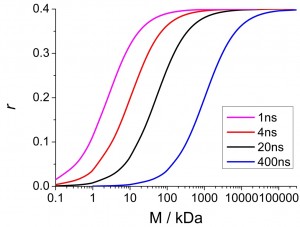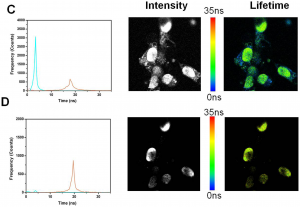Applications
Long fluorescence lifetime dyes such as KU530 and KU560 open new possibilities in R&D, FLIM, and polarisation assay. The dyes does not bleach under assay conditions and wide field illumination microscopy, which allow you to monitor you systems for extended time periods. The long fluorescence lifetime of KU530 extends the limits of polarisation based assay, while time-resolved microscopy can be used to achieve unsurpassed contrast in bioimaging.
- Polarisation response recorded for a given protein mass as a function of dye fluorescence lifetime
- FLIM image of 4T1 endothelial cell line stained with DAOTA
KU450 and KU470 are very bright fluorescein-type fluorescent dyes, some of the only high brightness dyes for excitation below 500 nm. KU dyes also offer a series of rhodamine and cyanine replacement dyes in the region from 470 nm to 550 nm. In the red we are currently developing two new long fluorescent lifetime dyes the first is KU600.
Application notes and scientific papers
Assays
- ConA-based glucose sensing using the long-lifetime azadioxatriangulenium fluorophore
- Azadioxatriangulenium: a long fluorescence lifetime fluorophore for large biomolecule binding assay
- The interactions between a small molecule and G-quadruplexes are visualized by fluorescence lifetime imaging microscopy
Bioimaging
- Long-lived bright red emitting azaoxa-triangulenium fluorophores
- Elimination of autofluorescence background from fluorescence tissue images by use of time-gated detection and the AzaDiOxaTriAngulenium (ADOTA) fluorophore
Advanced optical microscopy using long fluorescence lifetimes
- Generating multiple-pulse bursts for enhanced fluorescence detection
- Time-resolved confocal microscopy using lanthanide centred near-IR emission
Biophysical studies
- Azadioxatriangulenium: exploring the effect of a 20 ns fluorescence lifetime in fluorescence anisotropy measurements
- Elimination of autofluorescence in fluorescence correlation spectroscopy using the AzaDiOxaTriAngulenium (ADOTA) fluorophore in combination with time-correlated single-photon counting (TCSPC)


